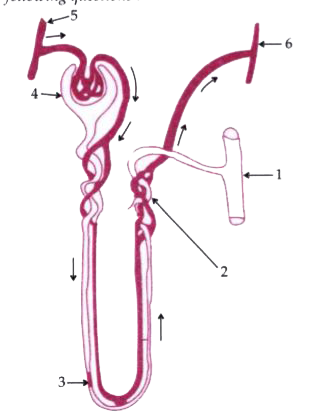Which blood vessel has the largest amount of urea ?
Dorsal aorta
Hepatic vein
Hepatic artery
Dorsal portal vein
The correct Answer is:B
To determine which blood vessel has the largest amount of urea, we can analyze the functions of the different blood vessels mentioned in the question: dorsal aorta, hepatic vein, hepatic artery, and dorsal portal vein.
1. Understanding Urea Production:
- Urea is a nitrogenous waste product formed primarily in the liver from the breakdown of amino acids. This process is known as deamination, where amino acids are converted into ammonia and then into urea.
2. Identifying the Role of the Liver:
- The liver is crucial for protein metabolism and urea formation. After urea is produced in the liver, it enters the bloodstream.
3. Examining the Blood Vessels:
- Hepatic Vein: This vessel carries blood away from the liver. Since the liver produces urea, the blood in the hepatic vein will have a high concentration of urea.
- Hepatic Artery: This vessel supplies oxygenated blood to the liver. It does not carry urea as it is bringing nutrients and oxygen to the liver for metabolism.
- Dorsal Aorta: This is a major artery that carries oxygenated blood to the body. It does not have a significant concentration of urea.
- Dorsal Portal Vein: This vessel carries blood from the digestive tract to the liver. While it may contain some urea, it is not as concentrated as the blood in the hepatic vein.
4. Conclusion:
- Since the hepatic vein is responsible for carrying blood away from the liver, where urea is produced, it will have the largest amount of urea compared to the other blood vessels listed.
Final Answer:
The blood vessel with the largest amount of urea is the hepatic vein.
- Urea is a nitrogenous waste product formed primarily in the liver from the breakdown of amino acids. This process is known as deamination, where amino acids are converted into ammonia and then into urea.
- The liver is crucial for protein metabolism and urea formation. After urea is produced in the liver, it enters the bloodstream.
- Hepatic Vein: This vessel carries blood away from the liver. Since the liver produces urea, the blood in the hepatic vein will have a high concentration of urea.
- Hepatic Artery: This vessel supplies oxygenated blood to the liver. It does not carry urea as it is bringing nutrients and oxygen to the liver for metabolism.
- Dorsal Aorta: This is a major artery that carries oxygenated blood to the body. It does not have a significant concentration of urea.
- Dorsal Portal Vein: This vessel carries blood from the digestive tract to the liver. While it may contain some urea, it is not as concentrated as the blood in the hepatic vein.
- Since the hepatic vein is responsible for carrying blood away from the liver, where urea is produced, it will have the largest amount of urea compared to the other blood vessels listed.
The blood vessel with the largest amount of urea is the hepatic vein.
Topper's Solved these Questions
- BIOTECHNOLOGY : PRINCIPLES AND PROCESSESBook:TRUEMEN BIOLOGY ENGLISHChapter:BIOTECHNOLOGY : PRINCIPLES AND PROCESSESExercise:MULTIPLE CHOICE QUESTIONS
Explore 124 Videos
- BREATHING AND EXCHANGE OF GASES Book:TRUEMEN BIOLOGY ENGLISHChapter:BREATHING AND EXCHANGE OF GASES Exercise:MULTIPLE CHOICE QUESTIONS
Explore 199 Videos
Similar Questions
Knowledge Check
Which blood vessel carries least amount of urea?
Apulmonary veinBrenal arteryCrenal veinDhepatic protal vein
Which ionic compound has the largest amount of lattice energy ?
View SolutionWhich ionic compound has the largest amount of lattice energy ?
View SolutionWhich blood vessels have the valves? What are they called as?
View SolutionWhich one of the following blood vessel in mammals contains least amount of urea :
View SolutionWhich one of the following blood vessel in mammals contains least amount of urea :
View SolutionWhich blood vessel will contain a high amount of glucose and amino acids after a meal
View SolutionWhich one of the following blood vessels in mammals would normally carry the largest amount of urea
View Solution
